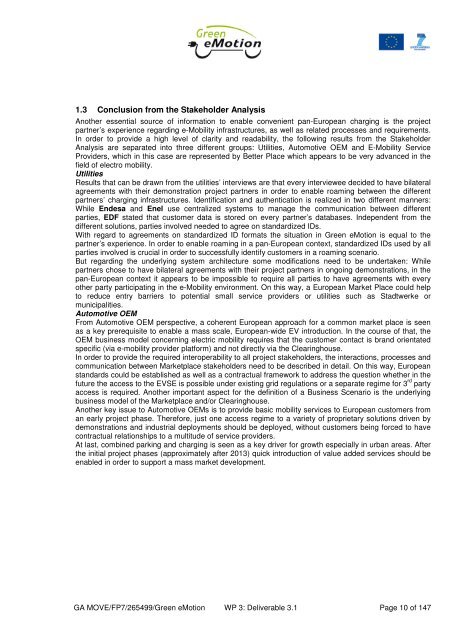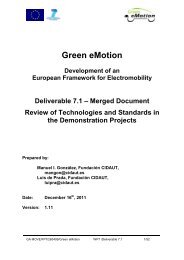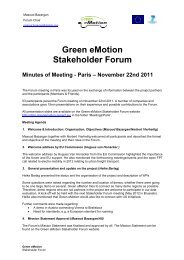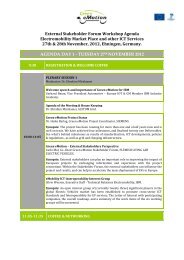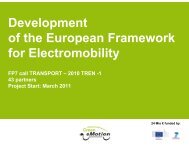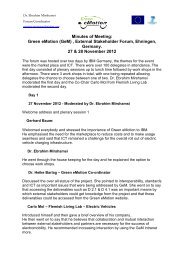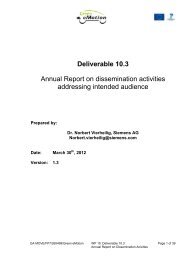Deliverable 3.1 Business Analysis - Green eMotion Project
Deliverable 3.1 Business Analysis - Green eMotion Project
Deliverable 3.1 Business Analysis - Green eMotion Project
Create successful ePaper yourself
Turn your PDF publications into a flip-book with our unique Google optimized e-Paper software.
1.3 Conclusion from the Stakeholder <strong>Analysis</strong><br />
Another essential source of information to enable convenient pan-European charging is the project<br />
partner’s experience regarding e-Mobility infrastructures, as well as related processes and requirements.<br />
In order to provide a high level of clarity and readability, the following results from the Stakeholder<br />
<strong>Analysis</strong> are separated into three different groups: Utilities, Automotive OEM and E-Mobility Service<br />
Providers, which in this case are represented by Better Place which appears to be very advanced in the<br />
field of electro mobility.<br />
Utilities<br />
Results that can be drawn from the utilities’ interviews are that every interviewee decided to have bilateral<br />
agreements with their demonstration project partners in order to enable roaming between the different<br />
partners’ charging infrastructures. Identification and authentication is realized in two different manners:<br />
While Endesa and Enel use centralized systems to manage the communication between different<br />
parties, EDF stated that customer data is stored on every partner’s databases. Independent from the<br />
different solutions, parties involved needed to agree on standardized IDs.<br />
With regard to agreements on standardized ID formats the situation in <strong>Green</strong> <strong>eMotion</strong> is equal to the<br />
partner’s experience. In order to enable roaming in a pan-European context, standardized IDs used by all<br />
parties involved is crucial in order to successfully identify customers in a roaming scenario.<br />
But regarding the underlying system architecture some modifications need to be undertaken: While<br />
partners chose to have bilateral agreements with their project partners in ongoing demonstrations, in the<br />
pan-European context it appears to be impossible to require all parties to have agreements with every<br />
other party participating in the e-Mobility environment. On this way, a European Market Place could help<br />
to reduce entry barriers to potential small service providers or utilities such as Stadtwerke or<br />
municipalities.<br />
Automotive OEM<br />
From Automotive OEM perspective, a coherent European approach for a common market place is seen<br />
as a key prerequisite to enable a mass scale, European-wide EV introduction. In the course of that, the<br />
OEM business model concerning electric mobility requires that the customer contact is brand orientated<br />
specific (via e-mobility provider platform) and not directly via the Clearinghouse.<br />
In order to provide the required interoperability to all project stakeholders, the interactions, processes and<br />
communication between Marketplace stakeholders need to be described in detail. On this way, European<br />
standards could be established as well as a contractual framework to address the question whether in the<br />
future the access to the EVSE is possible under existing grid regulations or a separate regime for 3 rd party<br />
access is required. Another important aspect for the definition of a <strong>Business</strong> Scenario is the underlying<br />
business model of the Marketplace and/or Clearinghouse.<br />
Another key issue to Automotive OEMs is to provide basic mobility services to European customers from<br />
an early project phase. Therefore, just one access regime to a variety of proprietary solutions driven by<br />
demonstrations and industrial deployments should be deployed, without customers being forced to have<br />
contractual relationships to a multitude of service providers.<br />
At last, combined parking and charging is seen as a key driver for growth especially in urban areas. After<br />
the initial project phases (approximately after 2013) quick introduction of value added services should be<br />
enabled in order to support a mass market development.<br />
GA MOVE/FP7/265499/<strong>Green</strong> <strong>eMotion</strong> WP 3: <strong>Deliverable</strong> <strong>3.1</strong> Page 10 of 147


